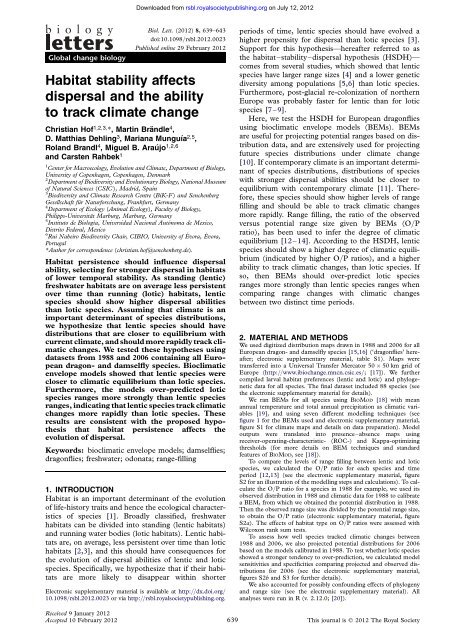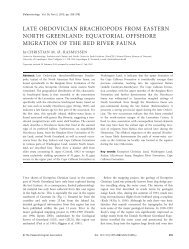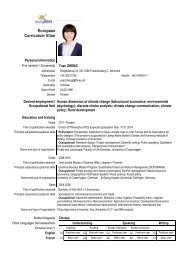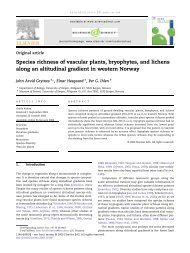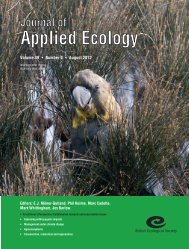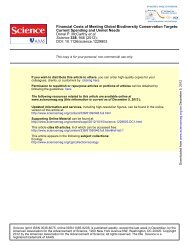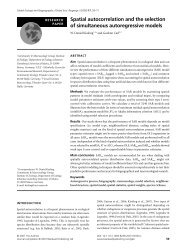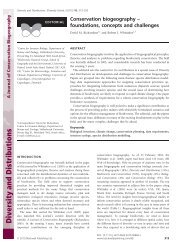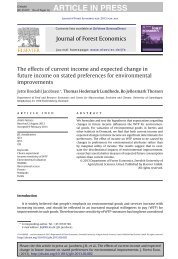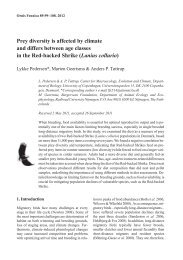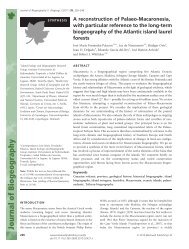climate change Habitat stability affects dispersal ... - 192.38.112.111
climate change Habitat stability affects dispersal ... - 192.38.112.111
climate change Habitat stability affects dispersal ... - 192.38.112.111
Create successful ePaper yourself
Turn your PDF publications into a flip-book with our unique Google optimized e-Paper software.
Downloaded from rsbl.royalsocietypublishing.org on July 12, 2012Global <strong>change</strong> biologyBiol. Lett. (2012) 8, 639–643doi:10.1098/rsbl.2012.0023Published online 29 February 2012<strong>Habitat</strong> <strong>stability</strong> <strong>affects</strong><strong>dispersal</strong> and the abilityto track <strong>climate</strong> <strong>change</strong>Christian Hof 1,2,3, *, Martin Brändle 4 ,D. Matthias Dehling 3 , Mariana Munguía 2,5 ,Roland Brandl 4 , Miguel B. Araújo 1,2,6and Carsten Rahbek 11 Center for Macroecology, Evolution and Climate, Department of Biology,University of Copenhagen, Copenhagen, Denmark2 Department of Biodiversity and Evolutionary Biology, National Museumof Natural Sciences (CSIC), Madrid, Spain3 Biodiversity and Climate Research Centre (BiK-F) and SenckenbergGesellschaft für Naturforschung, Frankfurt, Germany4 Department of Ecology (Animal Ecology), Faculty of Biology,Philipps-Universität Marburg, Marburg, Germany5 Instituto de Biología, Universidad Nacional Autónoma de Mexico,Distrito Federal, Mexico6 Rui Nabeiro Biodiversity Chair, CIBIO, University of Évora, Évora,Portugal*Author for correspondence (christian.hof@senckenberg.de).<strong>Habitat</strong> persistence should influence <strong>dispersal</strong>ability, selecting for stronger <strong>dispersal</strong> in habitatsof lower temporal <strong>stability</strong>. As standing (lentic)freshwater habitats are on average less persistentover time than running (lotic) habitats, lenticspecies should show higher <strong>dispersal</strong> abilitiesthan lotic species. Assuming that <strong>climate</strong> is animportant determinant of species distributions,we hypothesize that lentic species should havedistributions that are closer to equilibrium withcurrent <strong>climate</strong>, and should more rapidly track climatic<strong>change</strong>s. We tested these hypotheses usingdatasets from 1988 and 2006 containing all Europeandragon- and damselfly species. Bioclimaticenvelope models showed that lentic species werecloser to climatic equilibrium than lotic species.Furthermore, the models over-predicted loticspecies ranges more strongly than lentic speciesranges, indicating that lentic species track climatic<strong>change</strong>s more rapidly than lotic species. Theseresults are consistent with the proposed hypothesisthat habitat persistence <strong>affects</strong> theevolution of <strong>dispersal</strong>.Keywords: bioclimatic envelope models; damselflies;dragonflies; freshwater; odonata; range-filling1. INTRODUCTION<strong>Habitat</strong> is an important determinant of the evolutionof life-history traits and hence the ecological characteristicsof species [1]. Broadly classified, freshwaterhabitats can be divided into standing (lentic habitats)and running water bodies (lotic habitats). Lentic habitatsare, on average, less persistent over time than lotichabitats [2,3], and this should have consequences forthe evolution of <strong>dispersal</strong> abilities of lentic and loticspecies. Specifically, we hypothesize that if their habitatsare more likely to disappear within shorterElectronic supplementary material is available at http://dx.doi.org/10.1098/rsbl.2012.0023 or via http://rsbl.royalsocietypublishing.org.periods of time, lentic species should have evolved ahigher propensity for <strong>dispersal</strong> than lotic species [3].Support for this hypothesis—hereafter referred to asthe habitat–<strong>stability</strong>–<strong>dispersal</strong> hypothesis (HSDH)—comes from several studies, which showed that lenticspecies have larger range sizes [4] and a lower geneticdiversity among populations [5,6] than lotic species.Furthermore, post-glacial re-colonization of northernEurope was probably faster for lentic than for loticspecies [7–9].Here, we test the HSDH for European dragonfliesusing bioclimatic envelope models (BEMs). BEMsare useful for projecting potential ranges based on distributiondata, and are extensively used for projectingfuture species distributions under <strong>climate</strong> <strong>change</strong>[10]. If contemporary <strong>climate</strong> is an important determinantof species distributions, distributions of specieswith stronger <strong>dispersal</strong> abilities should be closer toequilibrium with contemporary <strong>climate</strong> [11]. Therefore,these species should show higher levels of rangefilling and should be able to track climatic <strong>change</strong>smore rapidly. Range filling, the ratio of the observedversus potential range size given by BEMs (O/Pratio), has been used to infer the degree of climaticequilibrium [12–14]. According to the HSDH, lenticspecies should show a higher degree of climatic equilibrium(indicated by higher O/P ratios), and a higherability to track climatic <strong>change</strong>s, than lotic species. Ifso, then BEMs should over-predict lotic speciesranges more strongly than lentic species ranges whencomparing range <strong>change</strong>s with climatic <strong>change</strong>sbetween two distinct time periods.2. MATERIAL AND METHODSWe used digitized distribution maps drawn in 1988 and 2006 for allEuropean dragon- and damselfly species [15,16] (‘dragonflies’ hereafter;electronic supplementary material, table S1). Maps weretransferred into a Universal Transfer Mercator 50 50 km grid ofEurope (http://www.ibio<strong>change</strong>.mncn.csic.es/; [17]). We furthercompiled larval habitat preferences (lentic and lotic) and phylogeneticdata for all species. The final dataset included 88 species (seethe electronic supplementary material for details).We ran BEMs for all species using BIOMOD [18] with meanannual temperature and total annual precipitation as climatic variables[19], and using seven different modelling techniques (seefigure 1 for the BEMs used and electronic supplementary material,figure S1 for <strong>climate</strong> maps and details on data preparation). Modeloutputs were translated into presence–absence maps usingreceiver-operating-characteristic- (ROC-) and Kappa-optimizingthresholds (for more details on BEM techniques and standardfeatures of BIOMOD, see [18]).To compare the levels of range filling between lentic and loticspecies, we calculated the O/P ratio for each species and timeperiod [12,13] (see the electronic supplementary material, figureS2 for an illustration of the modelling steps and calculations). To calculatethe O/P ratio for a species in 1988 for example, we used itsobserved distribution in 1988 and climatic data for 1988 to calibratea BEM, from which we obtained the potential distribution in 1988.Then the observed range size was divided by the potential range size,to obtain the O/P ratio (electronic supplementary material, figureS2a). The effects of habitat type on O/P ratios were assessed withWilcoxon rank sum tests.To assess how well species tracked climatic <strong>change</strong>s between1988 and 2006, we also projected potential distributions for 2006based on the models calibrated in 1988. To test whether lotic speciesshowed a stronger tendency to over-prediction, we calculated modelsensitivities and specificities comparing projected and observed distributionsfor 2006 (see the electronic supplementary material,figures S2b and S3 for further details).We also accounted for possibly confounding effects of phylogenyand range size (see the electronic supplementary material). Allanalyses were run in R (v. 2.12.0; [20]).Received 9 January 2012Accepted 10 February 2012 639 This journal is q 2012 The Royal Society


